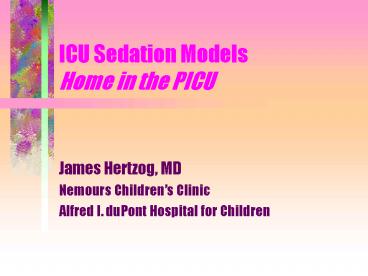ICU Sedation Models Home in the PICU - PowerPoint PPT Presentation
1 / 21
Title:
ICU Sedation Models Home in the PICU
Description:
increasing recognition of advantages of deep sedation: patient comfort, ideal ... 00740 (upper GI endoscopy) 00810 (lower GI endoscopy) Billing. Anesthesia CPT codes ... – PowerPoint PPT presentation
Number of Views:259
Avg rating:3.0/5.0
Title: ICU Sedation Models Home in the PICU
1
ICU Sedation ModelsHome in the PICU
- James Hertzog, MD
- Nemours Childrens Clinic
- Alfred I. duPont Hospital for Children
2
Why a PICU Sedation Service?
- increasing number of subspecialty procedures
- increasing recognition of advantages of deep
sedation patient comfort, ideal operating
conditions, efficiency - desire to optimize patient safety
3
Why a PICU Sedation Service?
- limitations in Anesthesia personnel availability
- desire to avoid the OR/parent satisfaction?/practi
tioner satisfaction? - AAP/ASA guidelines
- increasing JCAHO attention
4
Getting Started
- involve the Department of Anesthesiology and the
Department of Pediatrics - be consistent with published guidelines AAP,
ASA, JCAHO
5
Personnel
- Pediatric Intensivist
- Pediatric CCM Fellow
- Pediatric CCM APN/PA
- PICU RN
- PICU RRT
6
Scheduling
- elective procedures for ambulatory, ward, and
PICU patients - defined time slots during the day M-F that can be
booked - urgent/emergent procedures for ward and PICU
patients at discretion of team
7
Screening
- current and past medical history
- ASA physical status
- experience with anesthetics/sedatives
- intercurrent illness
- occurrence of allergic reactions to medications
or soy and egg proteins - fasting status
8
Screening
- PE of airway, cardiorespiratory, neurologic
- significant labs
- screening done at time of procedure
- fasting guidelines, time of procedure provided by
subspecialist beforehand
9
Pre-Procedure
- informed consent for anesthesia/sedation and
procedure - intravenous access-peripheral canula inserted or
CVL accessed
10
Procedure
- cardiorespiratory monitoring continuous ECG,
respiratory, SpO2, intermittent (q1-3 min) NIBP - pediatric intensivist
- monitors CR, neurologic status continuously
- administers propofol/other agent to maintain
desired level of sedation/anesthesia - provides supportive measures as needed
11
Procedure
- PICU RN
- monitors vital signs
- provides written documentation of course of
sedation/anesthesia on a standardized form - assists with supportive measures as needed
- neither involved directly with procedure
12
Procedure
- equipment at bedside
- BVM
- tonsillar suction catheter
- equipment for maintaining airway patency and
tracheal intubation - supplemental oxygen via blow-by
13
Post-Procedure
- monitoring continues after the procedure until
patient awake and able to ingest clear liquids
14
Post-Procedure
- discharge when meet predefined criteria defined
by AAP - stable and satisfactory airway patency and
hemodynamics - intact protective airway reflexes
- able to talk and sit unaided if age appropriate
- adequate state of hydration
15
Billing
- Anesthesia CPT codes
- 01999 (unlisted procedure)
- 00520 (bronchoscopy)
- 00532 (central venous access)
- 00740 (upper GI endoscopy)
- 00810 (lower GI endoscopy)
16
Billing
- Anesthesia CPT codes
- 00702 (percutaneous liver biopsy)
- 01112 (bone marrow aspiration/biopsy)
- 00635 (diagnostic or therapeutic lumbar puncture)
17
Billing
- other CPT codes
- 99141 sedation (moderate) analgesia-IV, IM,
inhalational - 99241 office consultation new or established
patient - 99251 inpatient consultation new or established
patient - key components problem focused hx and PE,
straightforward decision making, 15-20 min
18
Billing
- other CPT codes
- 90780 IV infusion for therapy/diagnosis,
administered by MD or under direct supervision of
MD, up to 1 hour - 90781 IV infusion for therapy/diagnosis,
administered by MD or under direct supervision of
MD, each additional hour, up to 8 hours
19
Advantages
- geographically localized-all done in one place
- resource utilization-all of the components are
already available - flexibility-PICU open 24/7
- comfort level
20
Challenges
- geographically localized-cant provide service
for procedures that cant be brought to the PICU - resource utilization-what if all the beds are
full or the RNs have assignments? - managing the scheduling
21
Challenges
- pre and post procedure evaluation
- QAI
- credentialing
- reimbursement































